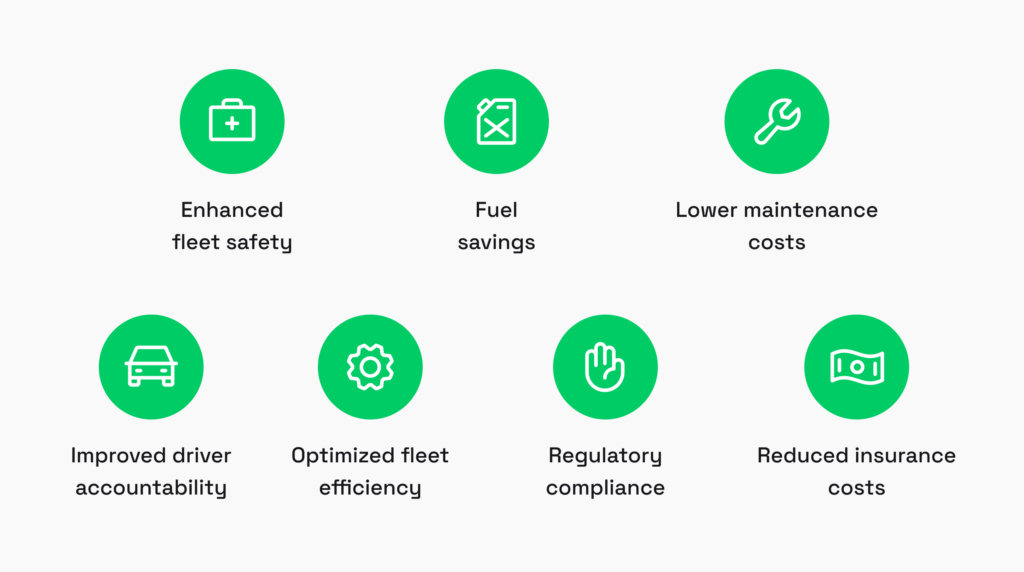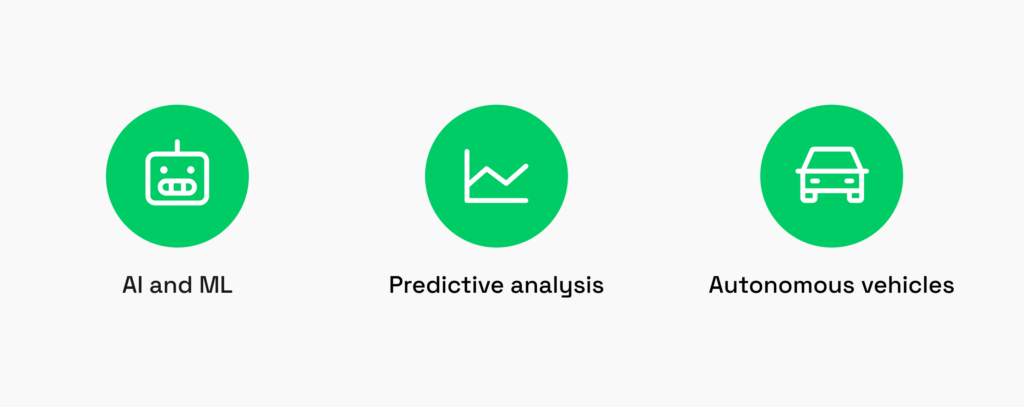A driver behavior monitoring system has become an indispensable tool for fleet managers seeking to optimize operations, reduce fuel and maintenance costs, and ensure the safety of drivers and vehicles on the road.
Regularly ranked among the Top Custom Software Development Companies on Clutch, our team at Volpis has spent years building custom software systems for fleet management businesses. In this article, we want to explore how driver behavior monitoring systems work, the significance of driver behavior data, and how it can specifically benefit fleet managers, helping to run more effective and safer fleets.
And if you have any questions about driver behavior tracking systems or developing a unique app for your company, we would be happy to answer all your questions and give honest advice. You can always reach out to us via info@volpis.com
What is a driver behavior monitoring system and why is driver data important?
A driver behavior monitoring system (DBMS) is technology that tracks how your drivers handle the road – whether they’re speeding, braking too hard, taking sharp turns, or idling for too long.
This data is collected using telematics, sensors, and GPS to give fleet managers insights into driving habits. It helps ensure drivers follow safety rules, use fuel efficiently, and keep vehicles in better shape, all of which cuts costs and keeps the fleet running smoothly.
Monitoring driver behavior isn’t just about avoiding accidents. Risky driving can lead to hidden costs like legal fees, insurance hikes, and lost productivity. By collecting and analyzing driver data, fleet managers can spot patterns – like excessive speeding or harsh stops – and address them before they lead to bigger problems.
The system provides on-demand safety data, allowing managers to see who their best and worst drivers are, complete with individual safety scores. This way, managers can reward top performers and coach those who need improvement, ultimately making the fleet safer and more efficient.
What data might be measured in the driver monitoring system?
Driver behavior data is all about understanding how your drivers handle the road, helping you tweak their habits. The DBMS collects all kinds of info in real-time. Here’s the breakdown:
| Data measured | Description | Devices used |
| Speed | Monitors if drivers are adhering to speed limits. | GPS, telematics devices |
| Aggressive driving (acceleration & braking) | Detects rapid acceleration and harsh braking, which increase vehicle wear and fuel consumption. | Accelerometers, Telematics Devices |
| Cornering | Identifies sharp or fast turns that indicate risky driving behavior. | Gyroscopes, Accelerometers |
| Idling time | Tracks how long the vehicle is idling, leading to wasted fuel and increased emissions. | Telematics Devices |
| Lane discipline | Monitors if drivers maintain lane positioning or perform unsafe lane changes. | Cameras, Lane Departure Sensors, GPS |
| Distracted driving | Detects signs of distraction, such as phone use or lack of attention. | In-cab Cameras, Driver Monitoring Sensors |
| Stop sign violations | Logs when drivers fail to stop at designated stop signs. | GPS, Telematics Devices |
| CSA score impact | Tracks how driving behavior impacts the Compliance, Safety, and Accountability (CSA) score. | Telematics Devices, Fleet Management Software |
| Fatigue detection | Identifies driver fatigue through eye movements, head positioning, and reaction times. | In-cab Cameras, Fatigue Monitoring Sensors |
| Seat belt usage | Monitors if drivers are wearing seat belts. | Seat Belt Sensors, In-cab Cameras |
| Fuel consumption | Tracks how efficiently fuel is used, considering driving behaviors and route choices. | Telematics Devices, Fuel Sensors |
| Route adherence | Ensures drivers stick to planned routes and avoid deviations that increase fuel use or travel time. | GPS, Telematics Devices |
| Speeding in specific zones | Monitors if drivers are speeding in restricted zones, such as school or construction areas. | GPS, Geofencing Systems, Speed Sensors |
| Excessive overtime driving | Tracks how long drivers are on the road without sufficient breaks, ensuring compliance with driving regulations. | Telematics Devices, Driver Activity Sensors |
| Collision detection | Detects potential or actual collisions and provides data for post-incident analysis. | Impact Sensors, Accelerometers, Cameras |
| Tailgating detection | Monitors if a driver is following another vehicle too closely, increasing accident risk. | Distance Sensors, Radar Systems |
All this data helps fleet managers get a handle on risky driving, train drivers better, and keep the whole operation running smoother.
How does a driver behavior monitoring system work?
Keeping things safe, efficient, and cost-effective is key to running a smooth operation. Here’s how driver monitoring systems get it done:
Data collection
The DBMS grabs data from telematics gadgets, GPS, and sensors in your vehicles. It tracks stuff like braking, speeding, where the vehicle is, how fast it’s going, and the route it’s taking.
Data transmission
The collected data gets sent to a central platform, usually in the cloud, where it’s processed and analyzed. Sometimes, the system does a bit of processing locally before it’s uploaded.
Driver performance analysis
The system checks out driver behaviors against set safety and performance standards. It flags risky moves like speeding or hard braking and gives each driver a safety score.
Alerts and reporting
Fleet managers get instant alerts if there’s unsafe driving, so they can jump in and address it right away. Detailed reports help track trends, compare driver performance, and make smart choices about fleet management.
Driver feedback and training
Some systems give drivers real-time feedback to help them fix their mistakes on the spot. Fleet managers can also use the data to create targeted training to boost safety and efficiency.
Top 7 benefits of driver behavior monitoring systems for fleet management

Without drivers, your fleet’s just a parking lot. They’re the ones making sure deliveries are on time, keeping the vehicles out of trouble, and avoiding accidents. Basically, they’re running the whole show, making sure everything’s efficient and productive day in, day out. But how do you keep them in check and make sure they’re doing all this the right way?
That’s where driver behavior monitoring systems come in, giving you all the tools. Here’s how driver behavior tracking systems can seriously up your game:
Benefit 1: Enhanced fleet safety
DBMS helps fleet managers spot and fix unsafe driving habits. By keeping an eye on things like speeding, hard braking, and distracted driving, it makes sure drivers stick to safety rules, cutting down on accidents and injuries.
Benefit 2: Fuel savings
Tracking driver behavior can save a ton on fuel. Things like aggressive acceleration, speeding, and idling burn through gas, but with DBMS, you can push for more fuel-efficient driving, potentially slashing fuel costs by up to 20%.
Benefit 3: Lower maintenance costs
Rough driving, like slamming on the brakes or speeding, wears out vehicles faster. By catching and fixing these habits, you can cut down on repair costs and make your vehicles last longer.
Benefit 4: Improved driver accountability
When drivers know they’re being watched, they’re more likely to drive safely and responsibly. This means fewer accidents, less damage, and a win-win for both the drivers and the company.
Benefit 5: Optimized fleet efficiency
DBMS gives you real-time updates on where your vehicles are, how fast they’re going, and if they’re sticking to their routes. This helps you fine-tune routes, speed up deliveries, and boost overall efficiency.
Benefit 6: Regulatory compliance
For fleets in industries with tight safety regulations, DBMS helps keep things compliant. It provides proof of safe driving and helps meet legal and industry standards.
Benefit 7: Reduced insurance costs
Many insurers give breaks to fleets using DBMS because it lowers accident risks. Show you’re serious about safety, and you might snag lower insurance premiums.
10 proven steps to implement a driver behavior monitoring system for your fleet
A driver behavior monitoring system gives you the tools to track what’s happening on the road in real-time. Here’s a breakdown of how to get started with implementing your own DBMS.
Step 1: Set your objectives
Before you even start shopping around for hardware or software, take some time to nail down exactly what you want to achieve with a DBMS. Common goals might include:
- Safety: Cutting down on risky behaviors like speeding and harsh braking.
- Efficiency: Reducing fuel consumption by promoting smoother driving.
- Accountability: Ensuring drivers are where they’re supposed to be and aren’t misusing company vehicles.
Once you have clear goals, think about what metrics will help you track progress. Some of the most popular ones include speeding, harsh braking, sharp turns, and distractions (like phone use or drowsiness).
Step 2: Choose your hardware
Now that you know what you want to achieve, it’s time to figure out what equipment you’ll need. The exact setup will vary depending on your goals, but most DBMS setups include a combination of the following:
- GPS trackers: To monitor speed, location, and routes.
- Accelerometers: To track sudden movements like harsh braking or rapid acceleration.
- Cameras: In-vehicle cameras can help track driver behavior (e.g., if the driver is looking at their phone).
- OBD-II devices: These plug into your vehicle’s diagnostics port to monitor engine performance and speed.
It’s important to pick hardware that’s compatible with your fleet and is reliable in capturing real-time data.
Step 3: Pick the right software
The software you choose is just as important as the hardware. This is the system that will process the data, generate reports, and send out alerts. You can either buy an off-the-shelf solution or develop something custom. Whichever option you choose, make sure it has these features:
- Data collection: It should pull data from GPS, accelerometers, and cameras.
- Real-time monitoring: You need a live dashboard where you can see what’s happening at any moment.
- Alerts: Set up notifications for speeding, erratic driving, or unscheduled stops.
- Reporting: You should be able to pull detailed reports on driver performance and overall fleet safety.
- Scalability: Make sure the software can grow with you as your fleet expands.
- System compatibility: Make sure the DBMS works with your current fleet setup and any other tech you’re already using. You don’t want any tech hiccups.
- Real-time data vs. batch data: Decide if you need live data for instant fixes or batch data for occasional check-ups. Real-time is great for quick reactions, while batch is better for detailed reviews.
- Customizable reporting: Go for systems that let you tweak reports and alerts to focus on what’s important for your fleet. You should be able to track the metrics that matter most to you.
- Ease of use: The system should be straightforward and user-friendly, so both fleet managers and drivers can get the hang of it without a hassle.
- Cost: Don’t forget to factor in all costs, including the hardware, software, installation, and any ongoing fees. You want to know what you’re getting into financially.
Step 4: Set up the telematics
Telematics is the backbone of a DBMS – it collects and sends the data from your vehicles to the software platform. Here’s how to get started:
- Install the hardware: Set up your GPS trackers and OBD-II devices in each vehicle.
- Connect the hardware to the software: Make sure your hardware is feeding data to the DBMS platform, whether through cellular networks or Wi-Fi.
- Configure the data flow: Ensure the system has a continuous data stream that you can monitor in real-time.
Step 5: Create feedback loops for drivers
One of the best things about a DBMS is the ability to provide immediate feedback to drivers, helping them adjust their habits on the fly. Here’s how you can do it:
- In-cab alerts: Audible beeps or voice alerts can notify drivers when they speed or brake too hard.
- Driver apps: Many platforms have companion apps where drivers can see their performance stats at the end of each shift.
- Regular reports: Send out weekly or monthly summaries so drivers can track their progress and see where they need improvement.
This feedback not only improves driving behavior but also boosts accountability.
Step 6: Set up a driver scoring and reward system
To motivate your drivers to improve, set up a scoring system that ranks drivers based on their performance. You could track:
- Number of speeding incidents
- How often they brake hard
- Smoothness of cornering and acceleration
With this, you can create a reward program that offers incentives like bonuses or even just recognition for top performers. Likewise, drivers who perform poorly could be flagged for additional training.
Step 7: Analyze data and make adjustments
Once everything is set up, you’ll start collecting tons of data. Use this to fine-tune both your DBMS and your fleet operations:
- Look for patterns: Are certain drivers consistently showing risky behaviors? Are some routes causing more problems than others?
- Optimize routes: You may be able to use data to choose more efficient routes, which saves time and fuel.
- Create reports: Regular reports will help you track how well your drivers are improving over time.
Step 8: Train drivers and managers
Technology is only as good as the people using it. Make sure everyone in your fleet understands how the DBMS works:
- Driver training: Explain how the system works, what data is being collected, and how they can improve their scores.
- Manager training: Teach fleet managers how to interpret data, give effective feedback, and manage alerts.
Ongoing training ensures your system is working to its full potential.
Step 9: Follow privacy and legal regulations
Since you’re collecting data about your drivers, make sure you’re following privacy laws and regulations. Some things to keep in mind:
- Data transparency: Clearly communicate to drivers what data you’re collecting and how it will be used.
- Legal compliance: Ensure your system complies with any local regulations regarding fleet management and employee monitoring.
Step 10: Review and improve the system regularly
The job doesn’t stop once your DBMS is up and running. Over time, you’ll want to:
- Audit the system: Make sure everything’s running smoothly and look for ways to improve.
- Review driver performance: Use the data to guide driver reviews and identify opportunities for improvement.
- Update the hardware and software: Technology moves fast, so make sure you’re keeping your system up to date.
Current trends and future of driver behavior monitoring systems

Looking ahead, driver behavior monitoring systems are about to level up big time. It is all about getting smarter, staying ahead of potential problems, and making sure that as technology evolves, your fleet stays safe and efficient. Here’s what’s on the horizon:
Trend 1: AI and ML
They’ll help you predict risky driving behaviors before they even happen. Imagine being able to spot potential issues and fix them before they turn into real problems—that’s what these techs are bringing to the table.
Trend 2: Predictive analysis
Instead of just reacting to issues after they happen, you’ll be able to anticipate them. This means spotting bad driving habits early and nipping them in the bud. It’s like having a crystal ball that helps keep your drivers in check and your fleet running smoothly.
Trend 3: Autonomous vehicles
As self-driving tech becomes more advanced, DBMS will be key in managing these semi-autonomous fleets. It’ll ensure that these high-tech rides stay safe and efficient, even as they take on more of the driving duties themselves.
How Volpis can bring your software idea to life
Regularly ranked among the Top Custom Software Development Companies on Clutch, Volpis has been leveraging the power of technology to assist fleet owners in reaching unparalleled milestones.
Our commitment to excellence is reflected in the glowing reviews from our customers, who consistently praise our dedication to delivering exceptional results.
Read more reviews from our valuable customers here
We invite you to explore our portfolio for a detailed look at the innovative software systems we have developed for our clients.
Our team understands the nuances of the fleet management industry and is committed to providing solutions that are tailored to your unique goals. We’d love to answer any questions you may have. You can reach out to us via info@volpis.com with any questions or to explore how we can be part of your journey.
Questions & Answers
FAQ
Driver behavior monitoring is the practice of tracking and analyzing how drivers handle their vehicles. It involves using telematics systems and fleet management software to capture data on driving habits such as speed limits and rapid acceleration. This data helps to monitor driver behavior, understand aggressive driving behaviors and vehicle misuse (and to address misuse promptly). By monitoring driver behavior, fleet managers can identify patterns and address issues like excessive speeding or drowsy drivers before they lead to accidents. Most fleet management systems include features for driving behavior monitoring, providing key performance metrics that help enhance road safety. The goal is to improve overall fleet safety, reduce maintenance costs, and ensure compliance with driving laws and safety protocols. Regularly reviewing driver data also aids in maintaining a safety culture within the fleet.
Driver behavior management refers to the strategies and actions taken to influence and improve how fleet drivers operate their vehicles. It includes the use of fleet management systems to monitor driving behavior, such as adherence to speed limits and avoidance of aggressive driving behaviors. By analyzing driver data from advanced driver assistance systems, fleet managers can implement targeted interventions to address issues like vehicle abuse or harsh braking. Driver behavior management involves setting up key performance metrics and utilizing driver scorecards to track progress. Effective management helps in reducing operational costs, enhancing driver safety, and ensuring compliance with traffic laws. It also plays a role in preventing vehicle misuse and improving overall driving performance. In essence, it’s all about monitoring driving behavior to create a safer, more efficient fleet.
A driver monitoring system tracks and evaluates various aspects of driver behavior to ensure safe and efficient fleet operations. It collects data on driving performance, including speeding events and rapid acceleration, using vehicle tracking and telematics systems. The system helps fleet managers monitor driving behavior, identify aggressive driving behaviors, and prevent vehicle abuse. By analyzing this data, a DMS can generate driver scorecards that highlight areas for improvement. This information supports the implementation of safety measures and reduces vehicle maintenance costs by addressing issues promptly. Additionally, a driver monitoring system contributes to reducing fuel consumption and enhancing overall road safety. It’s a vital tool for managing driver safety, optimizing fleet operations, and controlling operational costs.
To monitor your driver effectively, you use fleet management systems that incorporate telematics technology and vehicle tracking. These systems collect real-time data on driving behaviors such as speed limits, rapid acceleration, and harsh braking. By analyzing this data, you can track key performance metrics and identify aggressive driving behaviors or instances of vehicle misuse. Monitoring driver behavior also involves reviewing driver scorecards and maintenance data to address issues like excessive speeding or drowsy drivers. Fleet managers use this information to enhance safety protocols, reduce fuel consumption, and prevent vehicle abuse. Regular assessments of driving performance help in making informed decisions and improving overall fleet safety. By staying on top of driver behavior, you can ensure that they adhere to safe driving practices and improve operational efficiency.
Businesses invest in fleet data to improve driver’s behavior & safety, monitor driver fatigue, and reduce costs. By monitoring driver behavior and using telematics systems, companies can identify aggressive driving behaviors and prevent vehicle misuse. Fleet data provides insights into key performance metrics, allowing managers to track compliance with traffic laws and safety protocols. This information helps in reducing maintenance costs, optimizing fuel consumption, and addressing issues like excessive speeding. Investing in fleet data also supports the creation of a safety culture by promoting good driving habits and improving driver performance. Ultimately, it leads to cost savings, better customer satisfaction, and a more efficient fleet operation.

Kostya Khuta, the CEO of Volpis, is an expert in crafting custom software solutions for the Fleet Management, Logistics, and Transportation industry. With over 8 years of experience, he leads the way in delivering innovative and tailored solutions to meet industry-specific needs.





